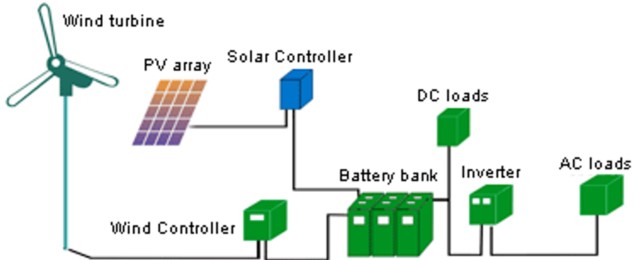- Definition and Types of Energy
- Myths And Misconceptions About Energy
- The Relationship Between Energy and Environment
- Climate Change and Carbon Footprint
- Greenhouse Gas Effect
- The Role of Human-Induced Greenhouse Gases and Energy Consumption
- Energy Efficiency and Sustainability
- Renewable Energy Sources and Future Perspectives
- Play and Learn
- Solar Energy Conversions
- Solar Energy Worldwide
- Solar Energy in Partner Countries
- Positive and Negative Impacts
- Technologies for Harnessing Solar Energy
- Solar thermal energy technologies and applications
- Electricity Generation Methods
- Passive Heating and Cooling of Residences with the Sun
- Concentrator solar power (CSP) systems and electricity generation
- Systems and Applications That Generate Electricity directly from solar rays
- Photovoltaic Cells and Panels
- Domestic PV Systems
- Off-Grid PV Systems
- Hybrid Connected Systems
- Materials Used in PV Cells
- Play and Learn
Solar and Wind Hybrid Systems
Today, photovoltaic solar energy and wind energy systems that operate independently of the grid are increasingly being used on a larger scale. Especially in regions where access to the grid is difficult or uneconomical, independent solar and wind energy systems offer an important solution. However, wind and solar energy are energy sources that vary daily, monthly and annually. Due to their low energy density, they may be insufficient to provide continuous and uninterrupted power. For example, solar energy systems may not be able to produce enough electricity on cloudy days, while wind energy systems cannot provide continuous power due to changing wind speeds throughout the year. This situation makes energy storage systems necessary to ensure continuity of energy production. Wind energy operates with higher efficiency in the winter months, while solar energy operates with higher efficiency in the summer months. The risk of being without electricity increases in the summer when only wind energy is used, and in the winter when only solar energy is used. For this reason, hybrid systems where solar and wind energy are used together provide more stable energy production than when they are used alone. In addition, the complementary operation of these two energy sources reduces the need for energy storage and helps the system become more efficient.
